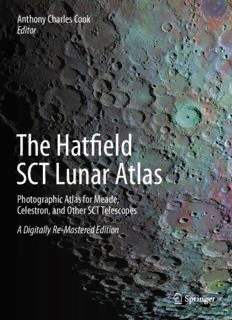
The Hatfield SCT Lunar Atlas: Photographic Atlas for Meade, Celestron, and Other SCT Telescopes: A Digitally Re-Mastered Edition PDF
Preview The Hatfield SCT Lunar Atlas: Photographic Atlas for Meade, Celestron, and Other SCT Telescopes: A Digitally Re-Mastered Edition
Anthony Charles Cook Editor The Hatfi eld SCT Lunar Atlas Photographic Atlas for Meade, Celestron, and Other SCT Telescopes A Digitally Re-Mastered Edition The Hatfi eld SCT Lunar Atlas Anthony Charles Cook The Hatfi eld SCT Lunar Atlas Photographic Atlas for Meade, Celestron, and Other SCT Telescopes A Digitally Re-Mastered Edition Anthony Charles Cook Newtown, UK ISBN 978-1-4614-8638-1 ISBN 978-1-4614-8639-8 (eBook) DOI 10.1007/978-1-4614-8639-8 Springer New York Heidelberg Dordrecht London Library of Congress Control Number: 2013949435 © Springer Science+Business Media New York 2014 This work is subject to copyright. All rights are reserved by the Publisher, whether the whole or part of the material is concerned, speci fi cally the rights of translation, reprinting, reuse of illustrations, recitation, broadcasting, reproduction on micro fi lms or in any other physical way, and transmission or information storage and retrieval, electronic adaptation, computer software, or by similar or dissimilar methodology now known or hereafter developed. Exempted from this legal reservation are brief excerpts in connection with reviews or scholarly analysis or material supplied speci fi cally for the purpose of being entered and executed on a computer system, for exclusive use by the purchaser of the work. Duplication of this publication or parts thereof is permitted only under the provisions of the Copyright Law of the Publisher’s location, in its current version, and permission for use must always be obtained from Springer. Permissions for use may be obtained through RightsLink at the Copyright Clearance Center. Violations are liable to prosecution under the respective Copyright Law. The use of general descriptive names, registered names, trademarks, service marks, etc. in this publication does not imply, even in the absence of a speci fi c statement, that such names are exempt from the relevant protective laws and regulations and therefore free for general use. While the advice and information in this book are believed to be true and accurate at the date of publication, neither the authors nor the editors nor the publisher can accept any legal responsibility for any errors or omissions that may be made. The publisher makes no warranty, express or implied, with respect to the material contained herein. Printed on acid-free paper Springer is part of Springer Science+Business Media (www.springer.com) This book is dedicated to Sir Patrick Moore (1923–2012) for inspiring generations of astronomers and space scientists . About the Editor Anthony Charles Cook, Ph.D., FBIS, FRAS, is both an amateur astronomer and a professional lunar and planetary cartographer. He has worked with many leading planetary cartography research groups in the UK, Germany, and the USA. He produced a planet-wide digital elevation model (DEM) of the Moon in the year 2000, and this was used by the European Space Agency to guide its SMART-1 spacecraft down to a precise impact. Six previously unknown impact basins larger than 300-km across were discovered using this lunar DEM. Presently, he is a lecturer at the Institute of Mathematics and Physics, Aberystwyth University, in the UK. He is Assistant Director of the British Astronomical Lunar Section and coordinates the Transient Lunar Phenomena observing program alongside a similar program for the Association of Lunar and Planetary Observers. He has also had Digital Planetary Cartography papers published in several refereed scienti fi c journals. Contents 1 Introduction ...................................................................................................................................................................... 1 Why a New Version of This Atlas? ................................................................................................................................... 1 The Maps: Overlaps, Scales, Grids .................................................................................................................................. 2 Nomenclature ................................................................................................................................................................... 2 The Libration Keys ........................................................................................................................................................... 3 The Moon’s Age and the Sun’s Selenographic Colongitude ......................................................................................... 3 The Digital Image Augmentation Process...................................................................................................................... 3 For Further Information .................................................................................................................................................. 5 2 Lunar Observing Techniques .......................................................................................................................................... 9 Projects for Beginners ...................................................................................................................................................... 9 Advanced Techniques ....................................................................................................................................................... 14 References ......................................................................................................................................................................... 22 3 Maps and Plates ................................................................................................................................................................ 25 4 Simulations of Sunrise and Sunset over Selected Areas ............................................................................................... 133 Appendices .............................................................................................................................................................................. 199 Appendix 1: Details about Commander Hatfield’s Photographic Plates ..................................................................... 199 Appendix 2: TLP Identification Flow Charts .................................................................................................................. 201 Appendix 3: Index of Named Formations ...................................................................................................................... 204
Description: